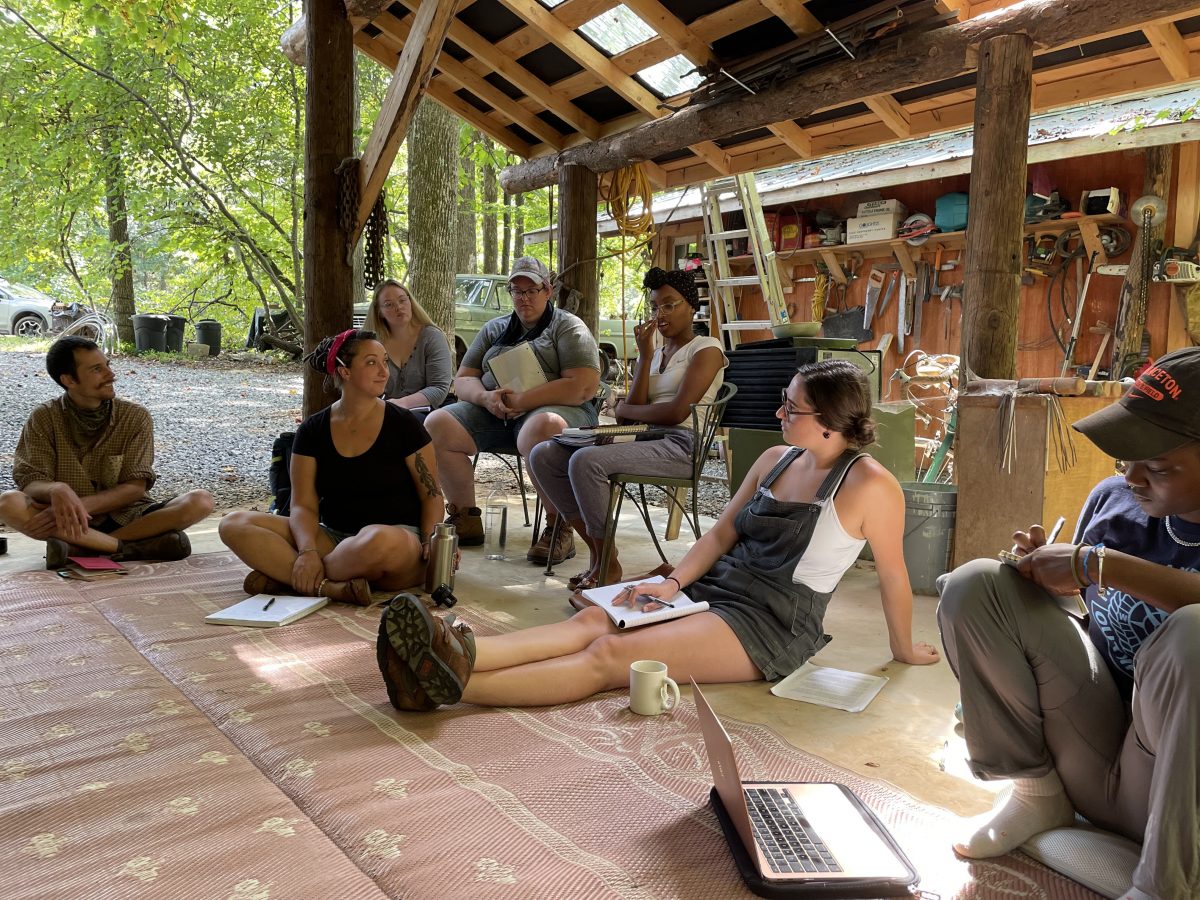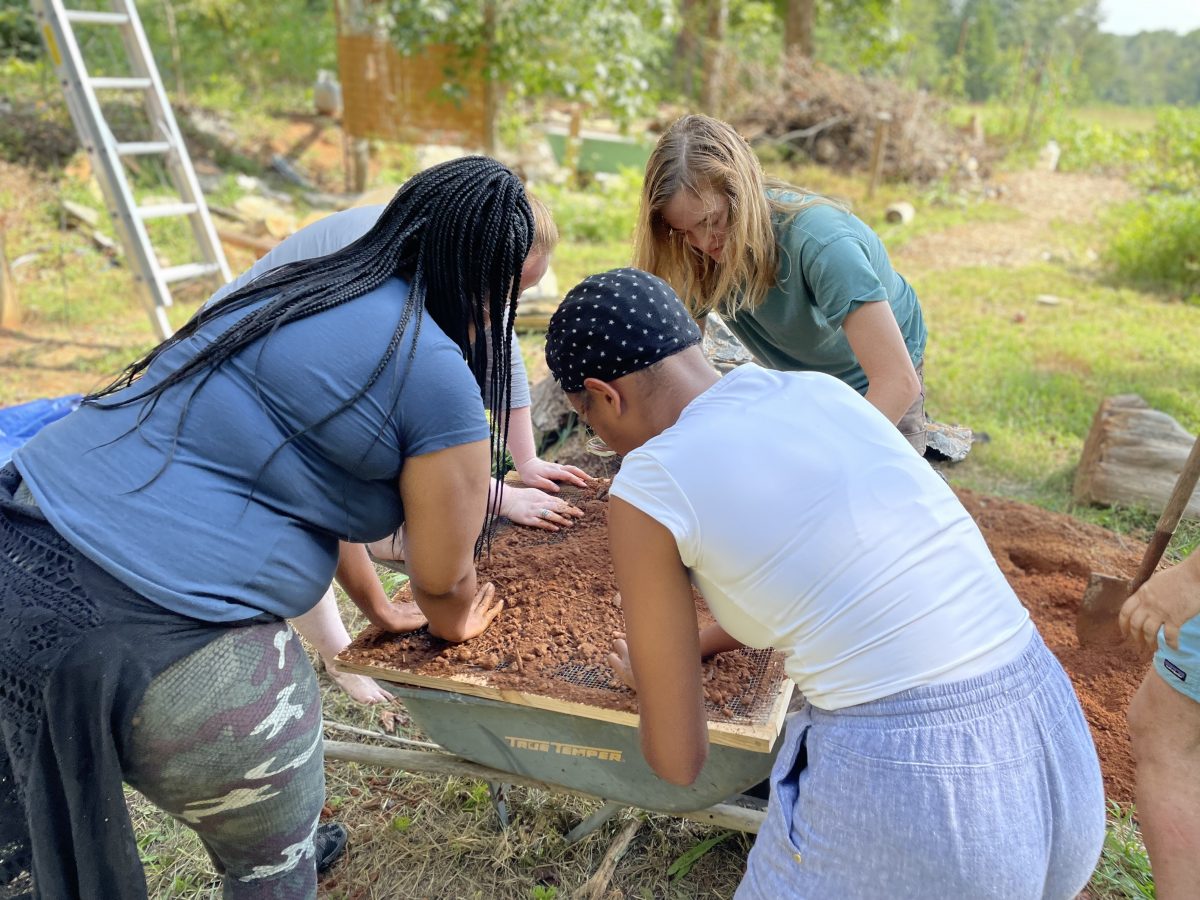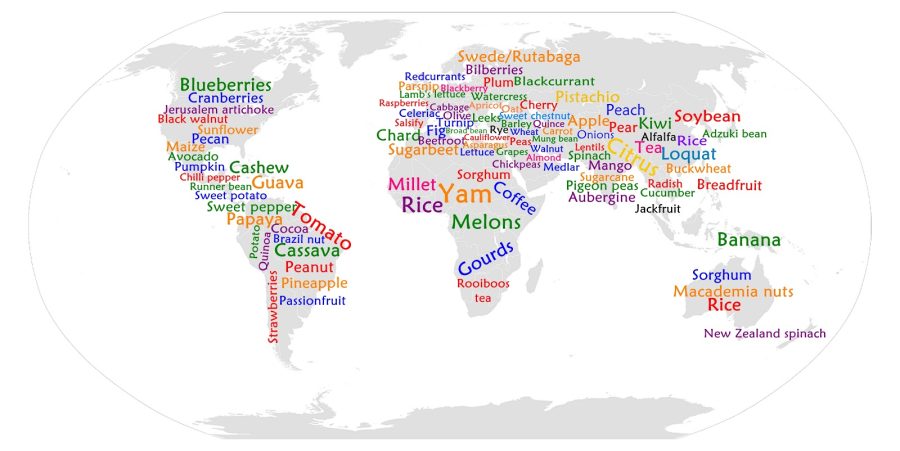Modern permaculture, built from traditional ecological knowledge has the opportunity to embrace the wisdom of indigenous perspectives, a frame-shift for the entire movement ripe in the present moment, as well as knowledge gleaned from the ever evolving and powerful social justice movement, if we can have to courage to reckon with the past.

On a Sunday we gathered together for the second day of our PDC. Students had listened to and read numerous readings on Social Permaculture and listened to A Growing Culture’s Hunger for Justice Broadcast Series: Composting Grief & Daring to Dream, Celebrating Black Land Ownership (Queen Quet + Tiffany Mouzon), The (R)evolution of North American Food Systems (The Sioux Chef), and many more.
A group of 13: one a past student returning to intern in the dream of building a teaching farm herself; another doing a work-trade, offering facilitation of discussion and improvisational poetry; five students in various disciplines from local universities; six adults who are university teachers, homesteaders, mothers, soil anyslist, veterinary technicians, artists, and more.
We span various identities: Puerta Rican, Black, Black/Indigenous, Latin American, Mexican, Iranian, European, South African, and more. Some come from backgrounds where parents and grandparents were a part of the Black Panther movement and on the forefront of working for Black liberation with MLK Jr. and others. Some come from backgrounds where parents and grandparents openly persecuted people of color; now, reckoning with what they were raised to believe. In the age of information, one shared she is seeking and has sought to rediscover and to define her belief systems for herself. A silence as we all take this in. But not uncomfortably. “Yes, wow,” a Black/Indigenous woman says.

We also span various gender identities. Not timidly, but with deep questing and true curiosity, a he/him student asks, “How do I know that it is safe to move to the country with my boyfriend? If we are surrounded by white cis gendered landowners, where do we find allies? How do we sleep at night? Will we be safe?” Another student, they/them, responds, “An edge effect, we have to seek not just allies but accomplices, people who straddle the fence who are willing to stand not beside, but in front of us, to truly welcome, to truly protect.” Shivers run through my body. Yes. Being an accomplice — this is what it will take. I shift my body in peaceful defiance.
I myself, of European descent, living on the same land my entire life, like my bones are made of this place and one day knowing that this place will be made of my bones, am so different from my neighbors who constantly shoot guns (literally at nothing, and at all hours), who set up deer stands beyond vast fields of corn and tobacco. I share. There are things I love about rural life, and my Southern rural identity: the cultural heritage of being an immigrant Southerner (meaning an immigrant/settler on this land, even if generations into that settling.) Not racism, ever, but spoonbread, a corn souffle like dish, recipe passed down generations, sorghum molasses parties, persimmon pudding, heat lightning, summer thunderstorms, the thousands of wild plants out my backdoor.
We began with a statement from “10+ Indigenous Leaders; Whitewashed Hope; How Regenerative Agriculture and Permaculture offer Narrow Solutions to Climate Crisis.” Far from being a negative decry of these movements, it asks us to deepen, to wade into, to frame shift the entire narrative. Powerful, a welcome. It is a reminder from the Pedagogy of the Oppressed (Freire) that those who have been oppressed have often transcended, not to begin the cycle again, but to abolish oppression within themselves and, thus, without, once and for all. “We invite you to ground your daily practices in these ancestral ways, as we jointly work towards collective healing.”
I have been practicing and teaching permaculture for nearly twenty years now, but it is not enough. I want a community of diversity. I want to shed the grief of knowing that land has been denied to the people of the rainbow, taken from them, and for it to be given back, “for words like integrity to be taken back into consideration again,” because a connection to land, to our Mother, is power and the sovereign inalienable right of every human being. It is not enough just to heal and connect with land. I want to care for people. I want an equal return of surplus to all land, all people.
I have been given the deep and untenable privilege of living on land and of generational wealth tied to the abundance that land offers. Long before my family stewarded this land, it was stewarded by the Eno, Saponi, Sauraton, and Sissipihau peoples. I opened the class by pointing to the headwaters of the Haw/Hau River to the South of where we sit. And rising up from the ground here, where thousands of arrowheads still lie, is a knowing that this land was once deeply loved and tended by those that came before. I feel them here and always have. This knowing that we love, have tended, and share the same land, separated only by time, which in my mind is illusory, feels a strange but sacred bond. Again – what would it mean to be an accomplice. We talk about #Landback, the movement to return land to indigenous and BIPOC hands to be tended and healed, and for abundance to grow and grow and grow as people “weave and tend” with Earth. We talk about community land trusts.
Why, why it asks: “Why were Indigenous homelands steal-able and why were our peoples & lands rape-able? Why were our cultures erased? Why does our knowledge need to be validated by ‘Science’? Why are we still excluded from your ‘healing’ of our land?” Powerful questions — and a response to the query from the indigenous perspective.“Among Indigenous cultures, people belong to land rather than land belonging to people. Healing of land MUST include healing of people and vice versa. Recognizing and processing the emotional traumas held in our bodies as descendants of assaulted, enslaved, and displaced peoples is necessary to the healing of land. Returning our rights to care for, harvest from, and relate to the land that birthed us is part of this recognition.”
I pause, “This is why I am reading this to you.” Our collective healing is bound up in recognition of the wrongs that have been done. Period. “Recognizing and healing all of our own traumas IS healing Earth’s traumas, because we are ONE.”
We are all aware in this modern day and age that environmental justice and social justice are irrevocably bound together.
I add, “And, I am reading this because permaculture is built from traditional ecological knowledge, and we have to acknowledge that from the get-go.Whether aboriginal or inuit, all indigenous peoples are deeply tied to place, to generosity, to the ethics and permanence of what Mollison coined ‘permaculture’.”
We cover the permaculture principles, we lay cardboard and sheet-mulch wild black cherries, black walnuts, pignut hickories, cedars, redbuds, and dogwoods – native trees that fed the ancestors, that will feed me in years to come.
Sitting again, Nich, the work/trade discussion facilitator asks: “What dreamscapes of future intersectionalities bring you to permaculture? I mean to say, what do you hope for the future?”
A reply, “I hope to empower others.” Another, “I just think that IF we have the capacity to help others we HAVE to. There is no other option.” Another, “I want to feed my people — MY people who don’t have blackcesible healthy food.” Another, “This is the only way forward, we have to practice permaculture. There is no alternative. Look at the state of this planet. Nothing corporate has worked. Nothing corporate has healed. This is the moment.”
We talk about Starhawk and her imagined futures, both dystopian and utopian. We talk about Emergent Strategies by Adrian Remi Brown. About Jillian Hishaw. We talk about hope. “I might be going down a rabbit hole here,” I say. “I know that a lot of people have negative things to say about the internet and about social media, and I know that there can be negative sides, but there is so much good. In the past year, social media has facilitated a global discussion surrounding social justice. THAT, is powerful.”
Another student goes on to say,“You know the people curating their internets to be hateful, comparative, or empty, are curating that in their external lives as well. Zone zero — curate your internet to be restorative.” I write that down, a quote for posterity. My students teach me as much as I teach them, a reciprocal series of relationships built on equality.
I read somewhere many years ago that Permaculture had to remain “scientific,” that the spiritual was not acknowledged by PIMA or some permacultural organization or another. A deeply connected and intuitive person, bound to the life of this Earth, moved by her, it always rubbed me the wrong way. Yet, I didn’t want to be ostracized, and went against my own intuition and denied myself the one tool that would make me a truly powerful teacher. My female co-founder and I were also mildly ostracized in the beginning for talking so much about social permaculture. Now, taking in the message from 10+ Indigenous Leaders deeply, I sigh in relief; things click into place. I am in right relationship to self, learning to be in right relationship to place and people, and growing as a teacher. If we are to meet the needs of the moment, we must deepen our awareness, sit with ourselves, “ground our daily practices in these ancestral ways, as we jointly work towards collective healing.”
Permaculture is rooted in indigenous knowledge, and it is their narrative we now must follow. It is a narrative that invokes a need for honesty, inclusion, collective healing, positive relationship between humans and earth, reparation, consciousness, and more.
While the ethics and origins of permaculture have taken earth care and fair share into account, and have in meaningful ways honored skills and knowledge from indigenous wisdom, it has yet to go far enough. Like all things, it is in cycle, evolving, and it is time to go deeper.
What grace to be invited into that awakening.
We have gathered in a flourishing way (“Let Us Gather in a Flourishing Way,” a poem by Juan Felipe Herrera that we began our grounding with), and now we close with a poem that I wrote years ago, but I don’t tell them this. It’s called,
“My Women Who Ask, These Women Who Listen.”
We are not all women, but I heard an intuitive voice within, telling me to share. I begin:
—–
Listening,
looking,
she finds words of truth.
She is searching
for cavernous worlds,
microcosms of beauty
inside the hearts of human
b e – i n g s.
On being,
on dreaming,
on daring to seek sublimely
pain,
but also humility,
reconciliation,
apologies,
heartfelt questing.
With her,
I travel to lands unknown,
so cadenced by the mundane,
that home is everywhere,
each and all becoming pure poetry,
intimacy prevailing.
With her I listen.
Vibrant truth thrums,
even when answers falter,
lingering in uncertainty,
bowing to time.
It is the steps taken to find healing,
the steps taken to walk
to our grandmother’s pueblo,
into our father’s suffering,
to wipe the tears away from his eyes,
to forgive our forefathers for trespassing
onto foreign land,
to take words like integrity
back into consideration again.
—–
Some days
I am with Mary Oliver
on the banks of some shore
listening to the chatter
of love’s embrace,
carefree, whimsical, and healed
by the gentle chaos of rippling beauty.
I need the swaying limbs,
the sky after rain,
the peace of sadness passed.
Some days
I am standing on the lip of grief
looking out into the canyon
so vast that I cannot walk away.
I sit in a mellow pool of
Awakening.
I sit and dive into my own caverns,
the heart wilting and yearning simultaneously
until enough is enough.
I drink cactus water
and walk back inland
ready for another day of making
bricks out of desert clay.
They ask, and I listen.
In their words and work
I find the strength to do my own —
The beautiful work
of laying stones
for peace.
—-
We sit silently for a moment. We rise, eat lunch, take off our shoes and all colored feet mash red clay soil. We do the hokey pokey on the land of the Sissipihau, the people who dwell along the creek. The past is real. It has bled, tortured, devoured, destroyed. It has fought, rebelled. It has breathed, sighed, surrounded, and evoked. It is not ignorable. So, here we are, talking about it. In the present moment, there is release. We have all been enculturated in one way or another. We all know the hokey pokey, we watch indigenous tik-tok. But we come together to bind old and new, to reconnect to the sacred. From 10+Indigenous Leaders:
“We are… ‘weavers,’ strengthening the bonds between all beings.”
“Life forms and transforms.”
“We give ourselves to the land: Our breath and hands uplift her gardens, binding our life force together. No one is tainted by our touch, and we have the ability to heal as much as any other lifeform.”
We mix and talk, we connect, we love, we respect, and with ecological care but also intuitive knowing, we gently repair things that have been broken, and together, in this poignant time of reckoning and patriarchal collapse, we gently, very gently, lay stones for peace.

Jenny L. Kimmel
Sow Permaculture



